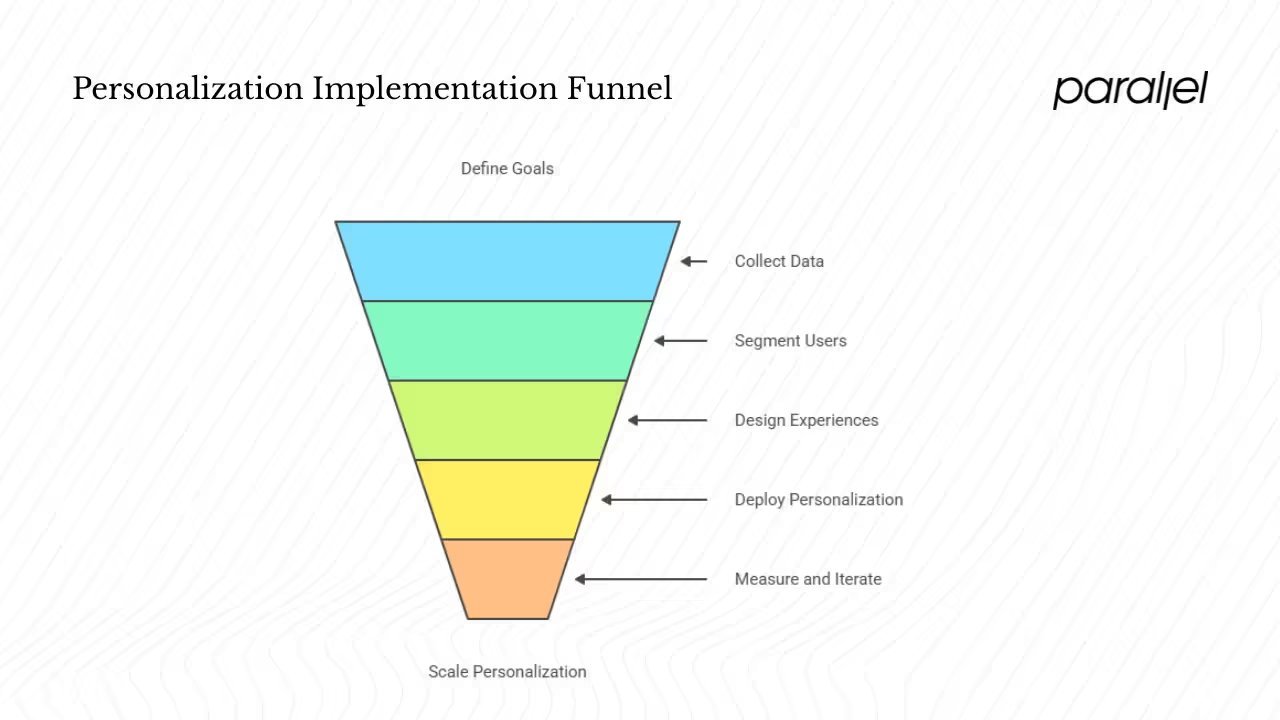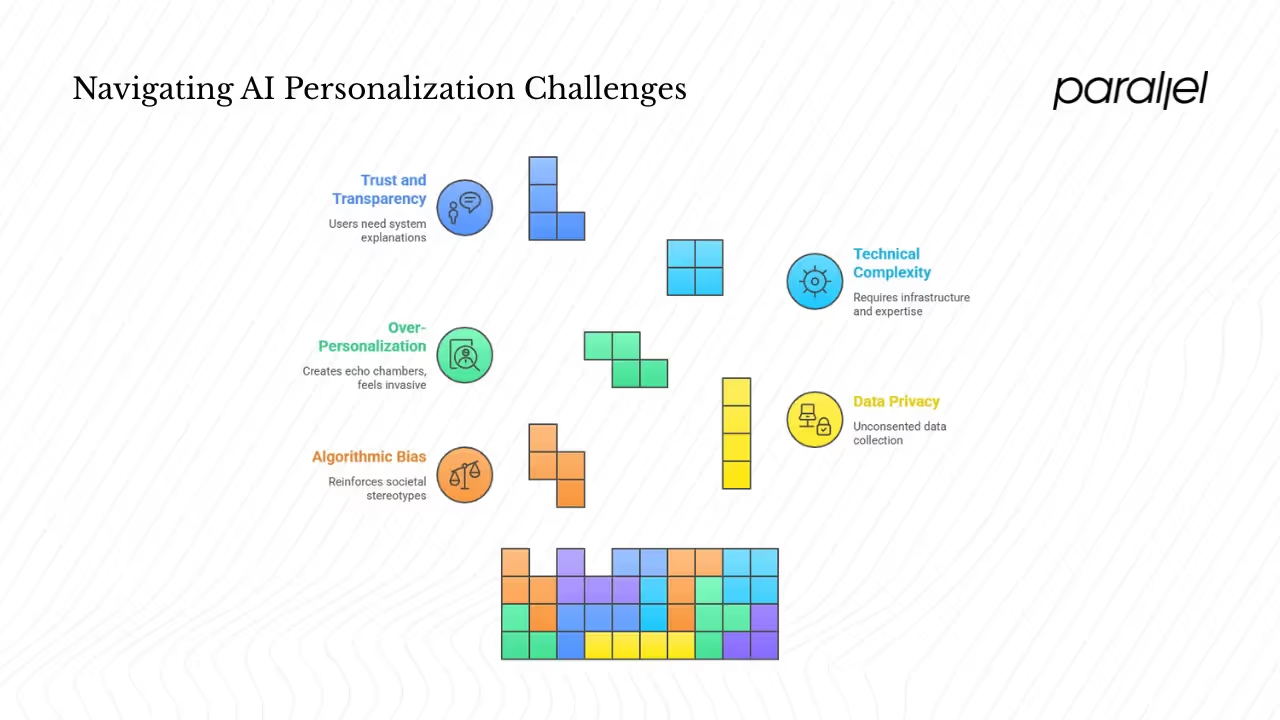Personalization in UX Using AI: Guide (2025)
Learn how AI enables personalized user experiences through recommendation engines, adaptive interfaces, and behavioral insights.

In an era where users can switch between apps in seconds, providing a one‑size‑fits‑all interface isn’t enough. People expect services to understand their tastes and adapt without fuss. This article looks at personalization in UX using AI, unpacking how artificial intelligence helps software respond to each individual’s needs. We’ll discuss why it matters, what technologies power it, how to build a strategy, and how to measure success. The following sections draw on recent research, case studies and our own experience helping early‑stage teams adopt machine‑learning‑driven custom experiences. Whether you run a startup or lead design and product teams, this guide offers practical insights on making interactions more personal and more human.
Why personalization matters for your product
Investing in personalized experiences isn’t just about pleasing users; it drives the bottom line. Studies show the market for customer experience and personalization software is forecast to grow from $7.6 billion in 2021 to $11.6 billion by 2026. According to Segment, 89 % of marketing decision‑makers consider personalization essential to business success in the next three years. Despite this, only 60 % of customers feel companies deliver personal experiences—a gap that presents a huge opportunity.
Personalized content keeps customers on your platform longer and increases spend. Fast‑growing firms generate 40 % more revenue from personalization than slower‑growing competitors. Businesses that excel at customer intimacy see quicker revenue growth, and personalised calls‑to‑action outperform generic versions by 202 %. A recent Emarsys study shows that extensive personalisation can increase average revenue per user by 166 %. Customers also feel the difference: 64 % of US shoppers say artificial‑intelligence‑driven experiences improved their retail interactions—a 25 % increase over 2023.
Retention improves as well. 62 % of business leaders report higher retention from personalisation, and 60 % of shoppers expect to return after a personalised shopping experience. On the flip side, 76 % of customers feel frustrated when experiences aren’t personalised, and 62 % say they lose loyalty when brands reduce them to statistics. For early‑stage startups, these numbers mean that thoughtful customization can differentiate you from incumbents with larger budgets. Even small improvements in conversion or retention translate into significant revenue when compounded across growth cycles.

How artificial intelligence powers personal experiences
Under the hood, personalised user experiences rely on machine‑driven insights rather than guesswork. Modern personalization in UX using AI uses algorithms to observe behaviour, infer preferences and adjust interfaces in near real time. Kagan Yegin explains that machine learning models—supervised, unsupervised and reinforcement learning—lie at the heart of these systems, enabling software to classify user behaviour, group similar preferences and continuously improve recommendations. Natural language processing allows services to interpret chat messages and support personalised customer service. Predictive analytics anticipate what a user will need next, while real‑time adaptation means homepages, playlists or offers can change in response to new actions.
Streaming platforms like Netflix and Spotify show how this works in practice. They analyse browsing history, ratings and watch patterns to suggest content tailored to individual tastes. In healthcare, artificial intelligence looks at patient data to deliver personalised treatment reminders, while e‑commerce sites use collaborative filtering to suggest products similar to those a user has bought or browsed. Even chat interfaces benefit: natural language models respond to queries in a tone and style that align with user preferences.
Personalised design goes beyond simple recommendations. Hyper‑personalisation techniques use behavioural analytics and contextual signals—such as device type, time of day and recent actions—to change layouts, reorder navigation and adjust colour schemes. Promodo’s analysis of 2025 trends notes that artificial intelligence can adapt interfaces in real time, shortening the path to a target action and increasing session time. This approach uses demographic, behavioural and psychographic data to form a picture of each individual user. The result is a responsive experience that feels intuitive rather than intrusive.
Components of personalised experiences

1) Capturing individual preferences
Personalisation begins by understanding what each person likes. Systems gather explicit preferences through settings and profile data and infer implicit preferences from interaction history—clicks, page views, dwell times and search terms. Nielsen Norman Group clarifies that personalization is driven by the system: developers set up logic to identify users and deliver content or functionality that matches their role or interests. This differs from customization, where users manually adjust settingsnngroup.com. To build accurate profiles, start with clean and transparent data collection, communicate what information is being gathered and allow users to adjust or delete their data.
2) Behavioural analytics and instrumentation
Capturing meaningful behaviour requires good instrumentation. Recording click paths, time on task, search queries and feature usage helps reveal patterns. As Codora’s 2024 research shows, 90 % of UX professionals now incorporate artificial‑intelligence‑driven tools during research and analysis. These tools summarise notes, analyse transcripts and uncover themes. They also speed up research: 48 % of professionals cite speed as a main benefit, 30 % highlight automation and 37 % point to increased efficiency. High‑quality data allows prediction models to anticipate user needs—like when a user is likely to abandon a form—and intervene with assistance. Poor data yields incorrect assumptions and can annoy users. Early‑stage teams should instrument key flows with analytics packages and run regular audits to ensure the data remains accurate.
3) Algorithms and predictive modelling
Once data is collected, models turn it into actionable insights. Recommendation engines generally use one of three approaches: collaborative filtering, content‑based filtering or hybrid systems. Collaborative filtering compares users’ behaviour to find those with similar tastes and then suggests items one group enjoys to another. Content‑based filtering looks at the attributes of items a user has engaged with and recommends items with similar characteristics. Hybrid systems combine both strategies to improve accuracy and coverage.
Machine‑learning classification and clustering algorithms group users based on behaviours, while reinforcement learning adapts recommendations over time. Predictive models forecast whether a user will churn, purchase or engage with certain features. For instance, an e‑commerce site may predict that a customer who viewed running shoes and added socks to their cart will appreciate an offer on athletic apparel. Real‑time models then adjust the product page accordingly. These approaches work best when coupled with continuous feedback loops; as more data flows in, predictions improve.
4) Responsive content and adaptive interfaces
The most effective personalization in UX using AI extends beyond recommending products to shaping the entire interface. Adaptive design means the layout, navigation and content structure change to fit each user’s context and behaviour. Promodo’s research highlights that time spent on websites and apps is decreasing, so systems must present relevant information quickly. Analysing previous behaviour, artificial‑intelligence models can determine whether to present a dark or light theme depending on the time of day, reorder menus based on frequently used features, or surface specific resources for a user’s role.
This approach shortens the path to a desired action and increases session length. For example, Spotify uses interface adaptation alongside personalised playlists; your home screen shows your library, search and suggestions based on recent listening.
Responsive content delivery also considers context such as device type and network conditions. When a mobile user opens your app at night, the service may automatically switch to a low‑light mode and prioritize content that can be consumed quickly. For enterprise platforms, role‑based personalisation ensures that a manager sees reporting dashboards while an engineer sees task assignments. The key is to ensure these adaptations feel helpful rather than invasive.
5) Engagement optimisation and metrics
To know whether your personalisation strategy works, you need to track the right metrics. Conversion rates indicate whether users complete key actions. According to Firework’s 2024 guide, personalised experiences raise conversion rates by showing relevant products and content. Engagement metrics such as click‑through rate, average session duration and scroll depth reveal whether people interact with personalised content. Retention and repeat visits show long‑term satisfaction. Revenue per user highlights the financial impact, while feature adoption rates signal whether new personalised features appeal to your audience.
Balanced scorecards are essential: focusing only on click‑through rates could lead to sensational content that harms trust. Track satisfaction through surveys and direct feedback, and monitor opt‑out rates to detect when personalisation becomes too intrusive. Always respect privacy; many customers appreciate personalised experiences as long as they have explicitly shared the data.
Implementation strategy for startups and product teams
Early‑stage teams often assume that personalisation requires enormous data lakes and deep expertise. In practice, you can start small and scale as you learn. Here’s a step‑by‑step approach drawn from our work with artificial‑intelligence‑enabled products.

- Define goals and key metrics. Decide which outcomes matter most: reducing churn, increasing retention, boosting content consumption or guiding users to a core feature. Assign measurable targets (e.g., reduce onboarding drop‑off by 20 %).
- Instrument and collect data responsibly. Use analytics tools to capture behaviour across your app or website. Focus on critical flows first—signup, onboarding, checkout or content consumption. Ensure compliance with data regulations and give users control over what is collected. Clean, well‑labelled data speeds up modelling and reduces bias.
- Segment and model users. Start by segmenting users based on simple criteria: new versus returning, high‑value versus low‑value, frequent versus infrequent. Use clustering algorithms to find patterns in behaviour. Build or adopt recommendation models (collaborative filtering, content‑based or hybrid) for your domain.
- Design adaptive experiences. Work with your design team to create modular components that can change depending on user segment or behaviour. For example, design multiple home‑screen variants that emphasise different features. Use conditional logic in your code to select the variant that fits each user’s context.
- Deploy a personalisation layer. Implement a service that reads user data and selects the right content or layout. Many off‑the‑shelf platforms can handle this, or you can build a custom layer if you need more control. Start with a few simple personalisations—such as recommended articles or adaptive navigation—and gradually expand.
- Measure, experiment, iterate. Use A/B tests to compare personalised experiences against control versions. Track the metrics you defined earlier. Evaluate not just conversion but also satisfaction and opt‑outs. Iterate quickly; small tweaks often produce outsized gains.
- Scale thoughtfully. As your user base grows, ensure your architecture can handle real‑time inference. Invest in cloud infrastructure that scales with demand and monitor performance. Consider using auto‑scaling and caching to keep latency low.
This iterative framework lets founders and product leaders test hypotheses before investing heavily. It’s better to launch a focused minimum viable personalisation and refine it than to attempt a fully adaptive interface at the outset.
Design considerations for UX leaders
Adapting design for personalised experiences requires more than swapping out content. It demands a shift in how teams think about structure, ethics and collaboration. Here are key considerations for design and product leaders:
- Modular layouts and conditional flows. Build your interface as a set of interchangeable modules that can be rearranged or hidden. Anticipate multiple user paths and design smooth transitions between them. Avoid static page structures; instead, plan for adaptive templates.
- Make it feel natural. Good personalisation should feel like the system “just knows” you, not like it is manipulating you. Use subtle cues rather than flashy banners. For example, reorder a list based on past behaviour instead of injecting obvious advertisements. Promodo’s research warns that small and mid‑size teams may struggle with hyper‑personalisation due to cost and data volume, so focus on high‑impact areas first.
- Respect privacy and consent. Be transparent about what data you collect and why. Offer simple ways to opt out of personalisation and allow users to modify their profiles. According to Lumenalta, successful AI‑driven personalisation relies on real‑time analytics, user consent and robust governance. Users appreciate when companies explain how their data is used and limit collection to what is necessary.
- Collaborate across disciplines. Personalised experiences sit at the intersection of design, product management and data science. Encourage regular communication between these teams. Designers need to understand how algorithms function so they can design appropriate states for loading, error handling and edge cases. Data scientists need to be aware of design principles to avoid confusing or jarring transitions.
- Accessible and universal design. Personalisation should not exclude anyone. Ensure that adaptations respect accessibility guidelines—such as maintaining contrast ratios, providing keyboard navigation and supporting screen readers. Avoid bias by testing your models on diverse datasets and auditing for unfair outcomes, as highlighted by recent examples of gender and racial bias in hiring and healthcare algorithms.
Risks, challenges and ethics
Personalisation using artificial intelligence brings risks that teams must manage carefully:

- Algorithmic bias. Systems can inadvertently reinforce stereotypes if training data is skewed. The 2025 ethics report notes that bias persists in recruitment tools and medical diagnostics, often favouring certain genders or skin tones. Mitigate bias by using diverse training data, running bias audits and providing human oversight.
- Data privacy and surveillance concerns. Collecting behavioural data may cross ethical boundaries if done without clear consent. The same report cites cases where smart home devices stored voice data without consent and retail systems used facial recognition in ways users didn’t understand. Use privacy‑by‑design principles: collect only necessary data, anonymise wherever possible and let users opt out.
- Over‑personalisation and user fatigue. Too much personalisation can create echo chambers or feel invasive. When everything is customised, users may lose a sense of discovery and feel pressured. Balance personalised suggestions with opportunities to browse freely. Firework’s guide advises testing different degrees of personalisation to strike the right balance.
- Technical complexity and resources. Scaling real‑time personalisation requires infrastructure and expertise. Startups may not have the budget to train complex models or manage large datasets. Begin with simple rules or third‑party platforms before committing to custom models, and invest in talent and infrastructure gradually.
- Trust and transparency. Users need to trust the system. Provide explanations for personalised recommendations and allow feedback. Transparent messaging increases confidence and reduces perceptions of manipulation.
By proactively addressing these challenges, teams can harness the benefits of machine‑learning‑driven custom experiences while protecting users’ rights and wellbeing.
What’s next? Future trends
Looking ahead, personalised interfaces will become even more sophisticated. Several trends will shape the next wave of user experiences:
- Generative user interfaces. Advances in generative models allow systems to build interface layouts and content on the fly. Instead of choosing between pre‑designed templates, future systems might create unique layouts for each person based on their context and goals. Leading design researchers are already exploring this concept.
- Hyper‑personalisation and continuous learning. Real‑time learning systems will adjust recommendations and interfaces as users interact, without waiting for batch updates. Such systems combine behavioural data, contextual signals and predictive modelling to adjust experiences on the spot.
- Adaptive environments beyond screens. Voice assistants, augmented reality and virtual reality will provide personalised experiences across multiple senses. For example, virtual shopping assistants might present products in a 3D environment, while home assistants adjust lighting or music based on mood and past preferences.
- Long‑term memory and contextual awareness. Future systems will maintain long‑term models of user preferences across devices and sessions, enabling continuity. However, this raises new privacy questions and underscores the need for strong governance.
- Algorithmic transparency and regulation. As artificial‑intelligence‑powered experiences become pervasive, governments will require greater transparency and fairness. Teams should prepare by building explainability into their models and processes.
Key takeaways
Personalised experiences are no longer a luxury; they are a competitive advantage. Research shows that businesses embracing personalisation see higher revenue, greater customer loyalty and improved retention. Yet most companies still struggle to deliver on this promise. Achieving effective personalization in UX using AI requires more than tacking on a recommendation widget—it demands a thoughtful strategy that begins with clear goals, responsible data collection and ethical design. Machine‑learning algorithms, behavioural analytics and adaptive interfaces work together to make software feel more human.
Founders and product leaders should start small, focus on high‑impact areas and build toward continuous learning. Design leaders must create modular interfaces, respect privacy and champion accessibility. As artificial intelligence evolves, the line between static and adaptive experiences will blur. The opportunity is immense, but so is the responsibility to build fair, transparent and trustworthy systems.
FAQ
Q1. How is artificial intelligence used in personalisation?
Systems collect data on user behaviour and preferences, then apply machine‑learning models to predict what each person might need next. Collaborative filtering finds similar users, content‑based filtering looks at item attributes, and hybrid approaches combine both. Predictions drive responsive content, such as product suggestions, adaptive layouts and natural‑language responses.
Q2. How can artificial intelligence help with UX design?
Machine‑intelligence‑driven tools assist at every stage of the design process. During research, they summarise transcripts and identify patterns. During concepting, predictive models forecast how people will interact with a feature. In live products, they enable adaptive interfaces that reorder navigation, adjust themes and suggest relevant content. Designers also use natural language models to analyse feedback and generate test scenarios.
Q3. How do companies use generative models to personalise experiences?
Generative techniques can create content—text, images or interface layouts—based on individual profiles. For example, an e‑commerce platform might generate unique product descriptions or email copy for each shopper. Streaming services use generative playlists that combine songs based on mood and listening history. As generative models mature, they will produce entire user flows tailored to a person’s context.
Q4. Will artificial intelligence replace designers and product managers?
While machine intelligence automates certain tasks—such as analysing data and generating interface variations—human judgment remains irreplaceable. Designers provide context, empathy and ethical oversight. Product managers set strategy and ensure that personalisation aligns with business goals and user needs. Future workplaces will see deeper collaboration between humans and machines, with technology augmenting rather than replacing human creativity.











.avif)

